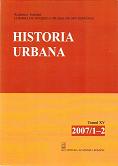Bănci româneşti în Oradea
Romanian Banks in Oradea
Author(s): Ion ZaineaSubject(s): History
Published by: Editura Academiei Române
Keywords: Bihoreana Bank; Oradea; charity actions;
Summary/Abstract: The main Romanian bank in Oradea was Bihoreana. The Bihoreana bank was set up in 1898 and it fulfilled honestly its role of creditor for the peasants in Bihor County and, in general in Transylvania which could purchase in this way, first of all arable ground, but also pastures, forests and orchards, from the estates which the Hungarian nobility, the different clerical institutions or banks were putting them for sale. With the help of the lends gave by Bihoreana, other Romanian peasants built houses, purchased agricultural equipments, seeds, while other people redeemed their ground from the money lenders’ hands. The Romanian education in Transylvania has especially benefited from the fond destined to charity actions, the bank’s leadership granting prizes to the Romanian teachers who were organizing lectures for teaching people to read and write, but they gave help also to the churches and cultural societies, while the Romanian students from the Academy of Law in Oradea had been supported, too. Within the Great Romania, the Bihoreana bank knew an extension of the affairs. Involving more and more in industry and trade, Bihoreana takes part to set up a few financial, commercial and industrial institutions in Oradea and Bucharest, it contributes to increase the capitals of some financial institutions, it involves in commercial affairs bringing goods in commission from abroad, it sets up a department for goods with the mission of taking care of supplying the region with foods missing on the market. The modest institute before the war becomes an important factor of the Romanian economical – financial life, gathering around it the whole Romanian breathing in Oradea and Bihor County binding the border of this area to the important centres in Transylvania and the old Kingdom. It didn’t give up its mission before the war, remaining an important supporting base for the peasants of the Romanian villages, for the helping of which it had open new subsidiaries in the county, at Beiuş, Salonta, Marghita, Ceica, Aleşd and Vaşcău. The government change that happened at the end of the 1928 year and that of its optics regarding the banking politics, had obliged Bihoreana at the Romanian National Bank insistences to accept the fusion with the Victoria Bank in Arad and the Timişana Bank in Timişoara, an act that happened on 15th June 1931. The agency that was set up in September 1920 and then the branch of the Romanian National Bank in Oradea, involved first of all in the action of “money unification”, on the areas of Bihor, Arad, Sălaj, Satu Mare and Maramureş counties extending later their activity upon all the banking operations resulting from the economical functions assigned to the Romanian National Bank. The branch activity was deeply marked by the events that have taken place after the Vienna’s Dictate, being evacuated to Arad, then Beiuş and Brad, coming back into the city by the river Crişul Repede in March 1945, at the same time with the North-Eastern Trans
Journal: Historia Urbana
- Issue Year: XV/2007
- Issue No: 1+2
- Page Range: 57-72
- Page Count: 16
- Language: Romanian
- Content File-PDF

